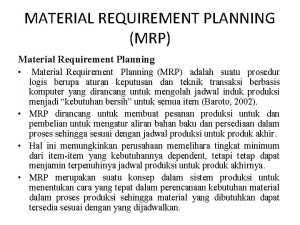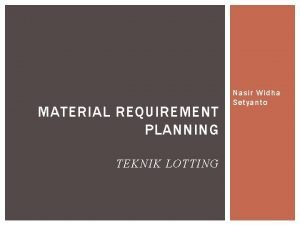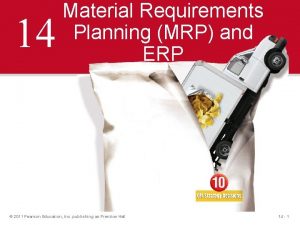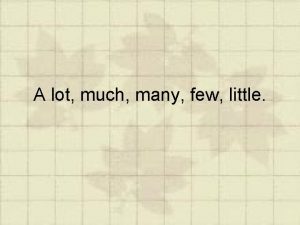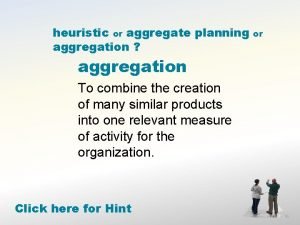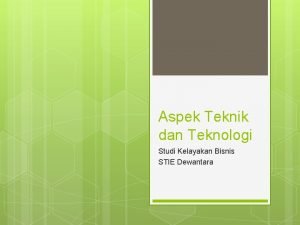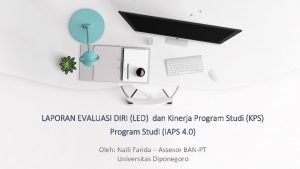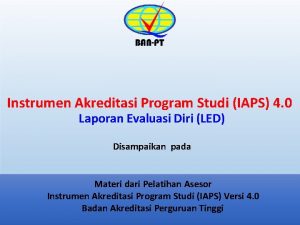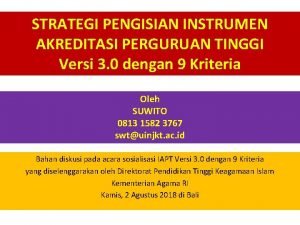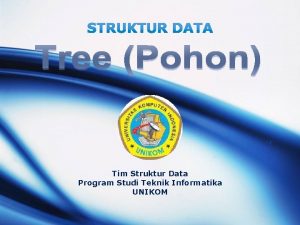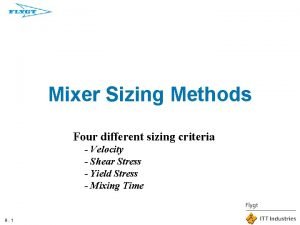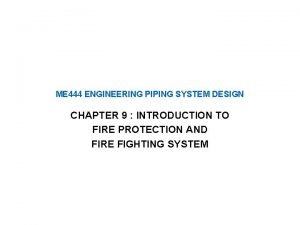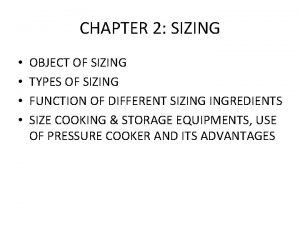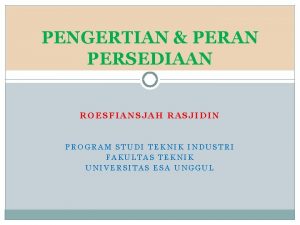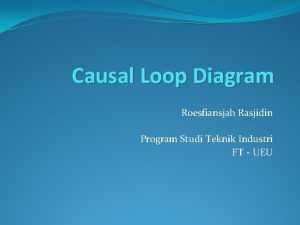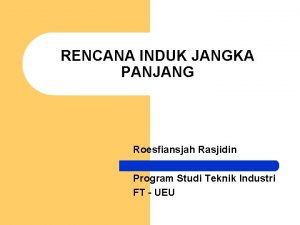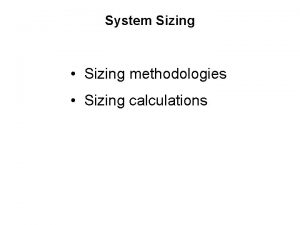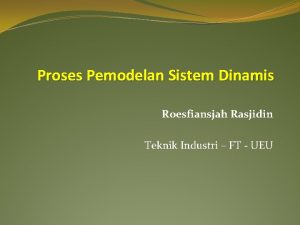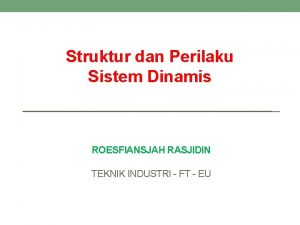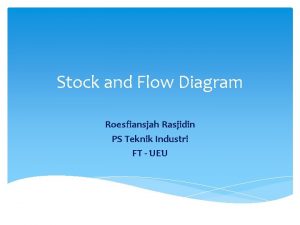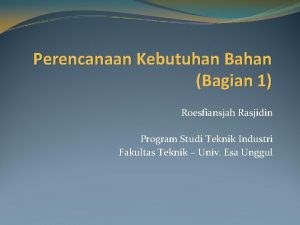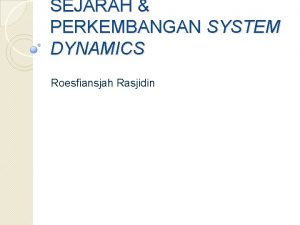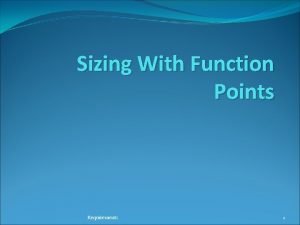Lot Sizing Lotting Roesfiansjah Rasjidin Program Studi Teknik























- Slides: 23

Lot Sizing (Lotting) Roesfiansjah Rasjidin Program Studi Teknik Industri FT - UEU

Teknik penentuan ukuran lot � 1. Lot- for-lot (L 4 L) � 2. Least Unit Cost (LUC) � 3. Least Total Cost (LTC) � 4. Part Period Balancing (PPB) � 5. Period Order Quantity (POQ) � 6. Wagner-Within

Net Requirements (NR) awal �Net Requirements (NR) sebelum penentuan ukuran lot (lot sizing) pada kondisi Projected On Hand (POH) awal = 0 dan Safety Stock (SS) = 0

Lot For Lot (LFL) �Pesan sejumlah yang diperlukan (tidak memerlukan on-hand-inventory) �Mengasumsikan bahwa order dapat dilakukan untuk jumlah berapapun

Hasil Lotting dengan LFL LT = 2 ; LS = L 4 L; SS = 0 PO Rel dari PORec periode 1 dan 2 jatuh di waktu lalu (awal periode -1 dan 0) sehingga diasumsikan sudah berupa SR pada periode 1 dan 2. Ongkos total = ongkos setup + ongkos simpan = 9 * $ 5, 75 + 0 = $ 51, 75

Least Unit Cost (LUC) � Pilih ongkos total per unit yang terkecil selama perioda berurutan � NR periode 1 hingga 4 digabung dalam satu lot yaitu PORec periode 1 sebesar 53 unit. NR periode 5 hingga 9 digabung dalam satu lot yaitu PORec 5 sebesar 52 unit.

Hasil Lotting dengan LUC � Karena PORel untuk PORec periode 1 jatuh pada masa lalu, maka diasumsikan sebagai SR pada periode 1 LT = 2; LS = LUC; SS = 0 Ongkos total = ongkos setup + ongkos simpan = 2 * $ 5, 75 + (41+26+17+44+34+18+11)*$0. 05 = $11, 5 + $9, 55 = $21. 05

Least Total Cost (LTC) � Mendapatkan ongkos total minimum, dengan mengabungkan beberapa kebutuhan bersih (NR) sampai kumulatif ongkos simpan mendekati sekali ongkos pesan. � Perhitungan untuk periode 1 hingga 5, menunjukkan bahwa penggabungan NR 1 hingga NR 5 sebagai lot pertama memberikan kumulatif biaya simpan $5, 8 yang berarti sudah paling mendekati ongkos pesan ($5. 75) Dengan cara yang sama lakukan perhitungan untuk periode 6 hingga 9. Hasil akan menunjukkan penggabungan NR 6 hingga NR 9 akan mempunyai kumulatif biaya simpan yang paling mendekati biaya pesan atau set-up ($5. 75) �

Hasil Lotting dengan LTC � � NR periode 1 hingga 5 digabung dalam satu lot yaitu PORec periode 1 sebesar 61 unit. NR periode 6 hingga 9 digabung dalam satu lot yaitu PORec 6 sebesar 44 unit. Karena PORel untuk PORec periode 1 jatuh pada masa lalu, maka diasumsikan sebagai SR pada periode 1 LT = 2; LS = LTC; SS = 0 Total biaya = 2*$5. 75 + (49+34+25+8+34+18+11)*$0. 05 = $20. 45

Part Period Balancing (PPB) � Variasi dari metode LTC, sehingga hasil lotting dengan PPB akan sama dengan LTC � Ongkos pesan dikonversi menjadi Equivalent Part Periods (EPP) EPP = s/k � s : ongkos pesan � k : ongkos simpan per part periode � � Penggabungan beberapa NR dilakukan hingga kumulatif part period mendekati EPP

Part Period Balancing (PPB) � Dengan s = $5. 75 dan k = $0. 05, maka EPP = $5. 75/$0. 05 = 115 part period � Perhitungan untuk periode 1 hingga 5, menunjukkan bahwa penggabungan NR 1 hingga NR 5 sebagai lot pertama memberikan kumulatif part period sebesar 116 yang berarti sudah paling mendekati EPP = 115 part period Dengan cara yang sama lakukan perhitungan untuk periode 6 hingga 9. Hasil akan menunjukkan penggabungan NR 6 hingga NR 9 akan mempunyai kumulatif part period yang paling mendekati EPP �

Hasil Lotting dengan PPB � � NR periode 1 hingga 5 digabung dalam satu lot yaitu PORec periode 1 sebesar 61 unit. NR periode 6 hingga 9 digabung dalam satu lot yaitu PORec 6 sebesar 44 unit. Karena PORel untuk PORec periode 1 jatuh pada masa lalu, maka diasumsikan sebagai SR pada periode 1 LT = 2; LS = LTC; SS = 0 Total biaya = 2*$5. 75 + (49+34+25+8+34+18+11)*$0. 05 = $20. 45

Period Order Quantity (POQ) Prosedur POQ : � Hitung EOQ (Economic Order Quantity) � Gunakan EOQ untuk menghitung frekuensi pemesanan per tahun (N) dengan persamaan N = R/EOQ, dimana R : kebutuhan tahunan �Hitung POQ dengan persamaan POQ = Jumlah Perioda Per Tahun/N �Bulatkan hasil POQ

Contoh Lotting dengan POQ � � � Demand per tahun, R = 1440 Ongkos pesan, s = $ 60/order Cost Rate of Carrying tiap unit persediaan, k = 0, 3/year Ongkos tiap unit, C = $ 90/unit Jumlah minggu per tahun = 50

Hasil Lotting dengan POQ � � NR periode 1 hingga 3 digabung dalam lot pertama (PORec 1) NR periode 4 hingga 6 digabung dalam lot kedua (PORec 4) NR periode 7 hingga 9 digabung dalam lot ketiga (PORec 7) Karena PORel untuk PORec periode 1 jatuh pada masa lalu, maka diasumsikan sebagai SR pada periode 1 LT = 2; LS = POQ; SS = 0

Algoritma Wagner-Within

Wagner-Whitin Model n Wagner and Whitin (1958) provided a method to determine an optimal solution for this problem u Their method relies on the following zero-inventory production property: F An optimal solution exists in which either the inventory carried from period t – 1 to t equals zero, or we produce nothing in period t, i. e. , It-1 Qt = 0 for all t. F Try to provide an intuitive argument for the justification of this property F This property allows us to consider only a subset of the possible production quantities in any period, i. e. , when I setup in period 1, I either produce D 1 units, D 1 + D 2 + D 3 units, …

Wagner-Whitin Approach n n n How does this property help us? We use a dynamic programming approach, in which we consider only a subset of the time horizon at each step. (Note that if ct is the same for all periods, then the total production costs will be fixed and we need not consider these costs in making our decision. ) Let Zi* denote the minimum total cost of an i-period problem. Let ji* denote the last period of production in an optimal solution to an i-period problem.

Wagner-Whitin Approach n Start with 1 -period problem: u Z 1* n Consider the 2 -period problem: u Z 2* F n = min{A 1 + h 1 D 2; Z 1* + A 2} If the first gives min, j 2* = 1; otherwise j 2* = 2. Consider the 3 -period problem: u Z 3* F n = A 1; j 1* = 1 = min{A 1+h 1 D 2+(h 1+h 2)D 3; Z 1*+A 2+h 2 D 3; Z 2*+A 3} If 1 st term gives min, j 3*=1; if 2 nd, j 3*=2; otherwise j 3* = 3. We continue this out until we obtain ZT*.

Wagner-Whitin Approach n When finished, we can trace our jt* values backwards to determine the periods in which production occurred. u For example, if j. T* = i, we know the last setup was in period i u We then check ji-1* to see when the previous setup occurred, etc. u At step t, we are computing the minimum cost for a t-period problem as follows: the minimum cost to reach the end of period t equals the minimum among: F Min. possible cost if the most recent setup was in period 1, F Min. possible cost if the most recent setup was in period 2, F …, F Min. possible cost if the most recent setup was in period t – 1, F Min. possible cost if the most recent setup was in period t.

Wagner-Whitin Example n n n t 1 2 3 4 5 Dt 20 50 10 50 50 ct 10 10 10 At 100 100 100 ht 1 1 1) Z 1*=A 1=100; j 1*=1 2) Z 2*=min{100+(1)(50); Z 1*+100} = 150; j 2*=1 3) Z 3*=min{100+(1)(50)+(2)(10); Z 1*+100+(1)(10); Z 2*+100} = 170; j 3*=1 4) Z 4* =min{100+(1)(50)+(2)(10)+(3)(50); Z 1*+100+(1)(10)+(2)(50); Z 2*+100+(1)(50); Z 3*+100} = 270; j 4*=4 5) Z 5* =min{100+(1)(50)+(2)(10)+(3)(50)+(4)(50); Z 1*+100+(1)(10)+(2)(50)+(3)(50); Z 2*+100+(1)(50)+(2)(50); Z 3*+100+ (1)(50); Z 4*+100} = 320; j 5*=4

Wagner-Whitin Example n Since j 5* = 4, the last setup was in period 4 u In that setup we produce all demand for periods 4 and 5, which implies Q 4 = 100 n Next we need j 4 -1*=j 3*=1, the setup prior to period 4 occurs in period 1 u In that setup we produce all demand for periods 1, 2, and 3, which implies Q 1 = 80. u Q 2, Q 3, and Q 5 all equal zero u The minimum total cost equals Z 5* = $320

DISKUSI & TANYA JAWAB
 Lotting adalah
Lotting adalah Lotting
Lotting Material requirements planning
Material requirements planning Put in much or many
Put in much or many Countable or uncountable water
Countable or uncountable water The lot-for-lot (lfl) rule
The lot-for-lot (lfl) rule Aspek teknik dan teknologi
Aspek teknik dan teknologi Led aps
Led aps Contoh rancangan evaluasi pembelajaran
Contoh rancangan evaluasi pembelajaran Led program studi
Led program studi Ipr dalam akreditasi
Ipr dalam akreditasi Tingkat kejenuhan program studi
Tingkat kejenuhan program studi Teknik informatika unikom
Teknik informatika unikom Starbucks brand equity
Starbucks brand equity Double lumen tube sizing
Double lumen tube sizing Position sizing techniques
Position sizing techniques Mixer sizing calculations
Mixer sizing calculations Fire fighting pipe sizes in mm
Fire fighting pipe sizes in mm Watchman sizing chart
Watchman sizing chart Geothermal loop sizing
Geothermal loop sizing Rhonda robb
Rhonda robb Acurate neo sizing chart
Acurate neo sizing chart Sweepable bodies ansys
Sweepable bodies ansys Object of sizing
Object of sizing
